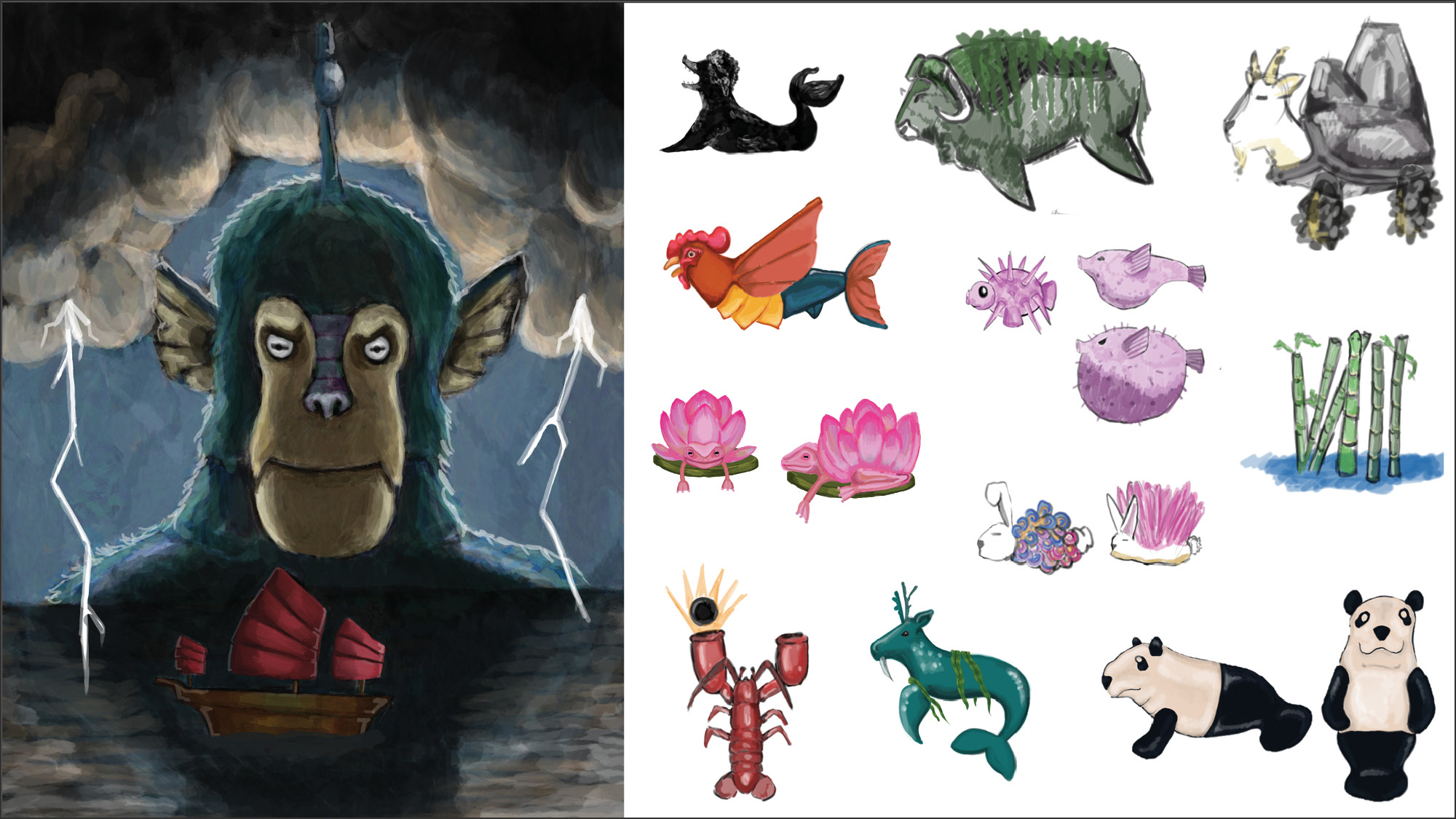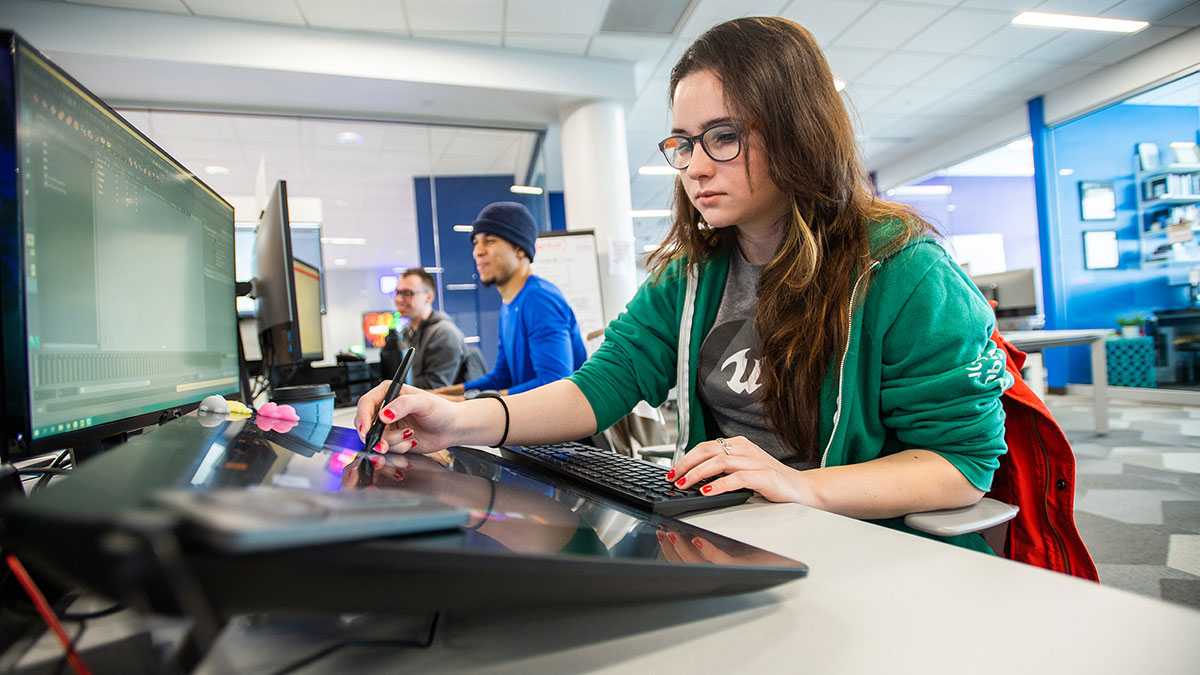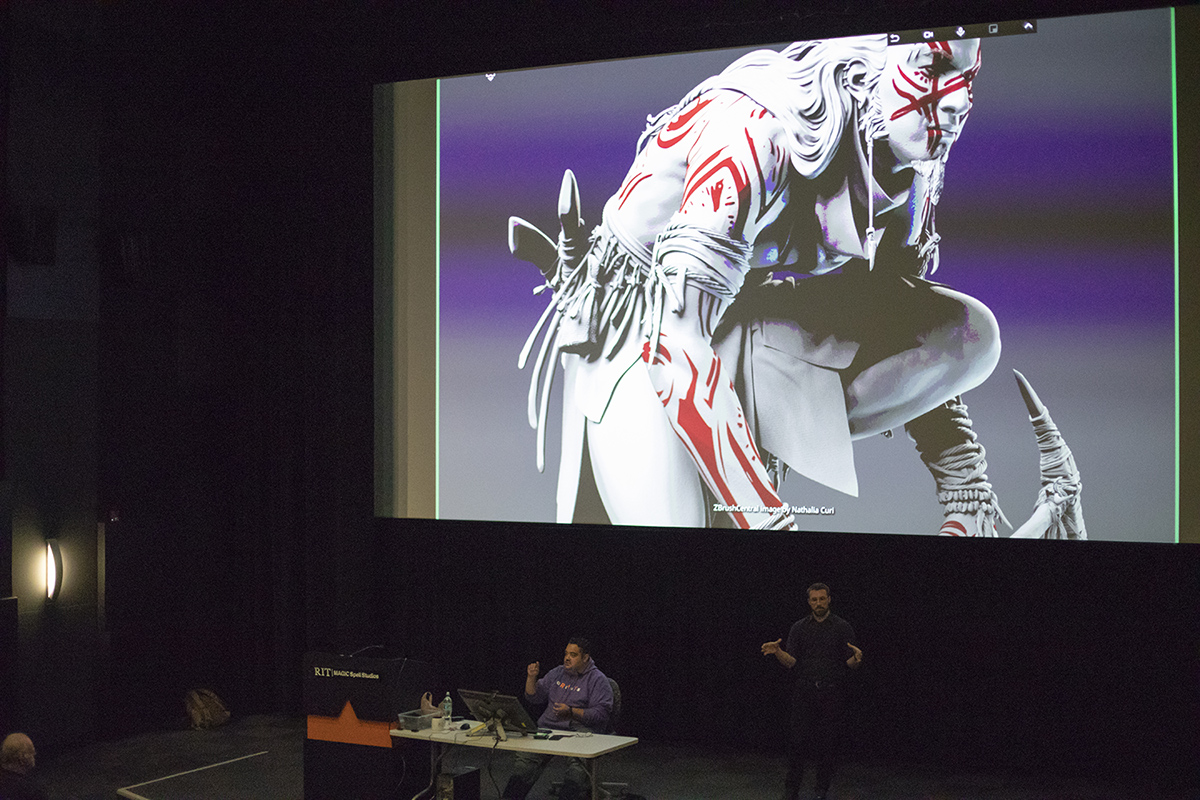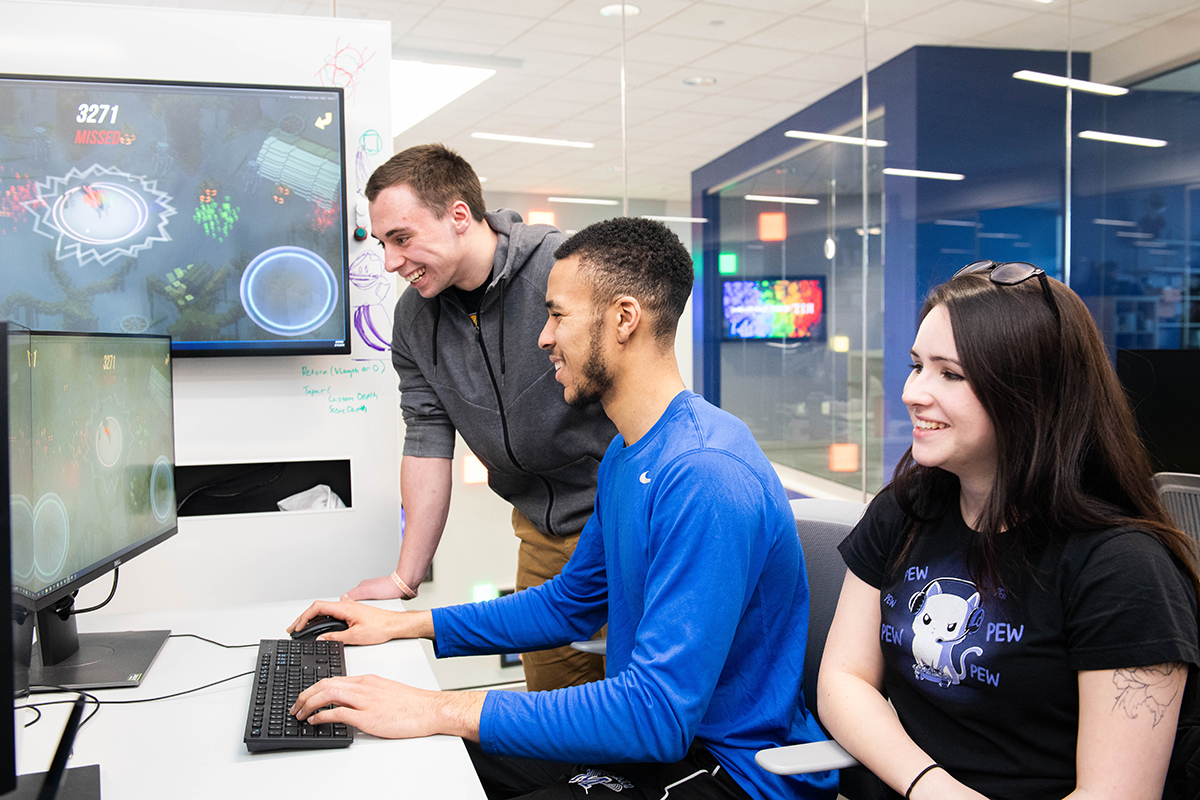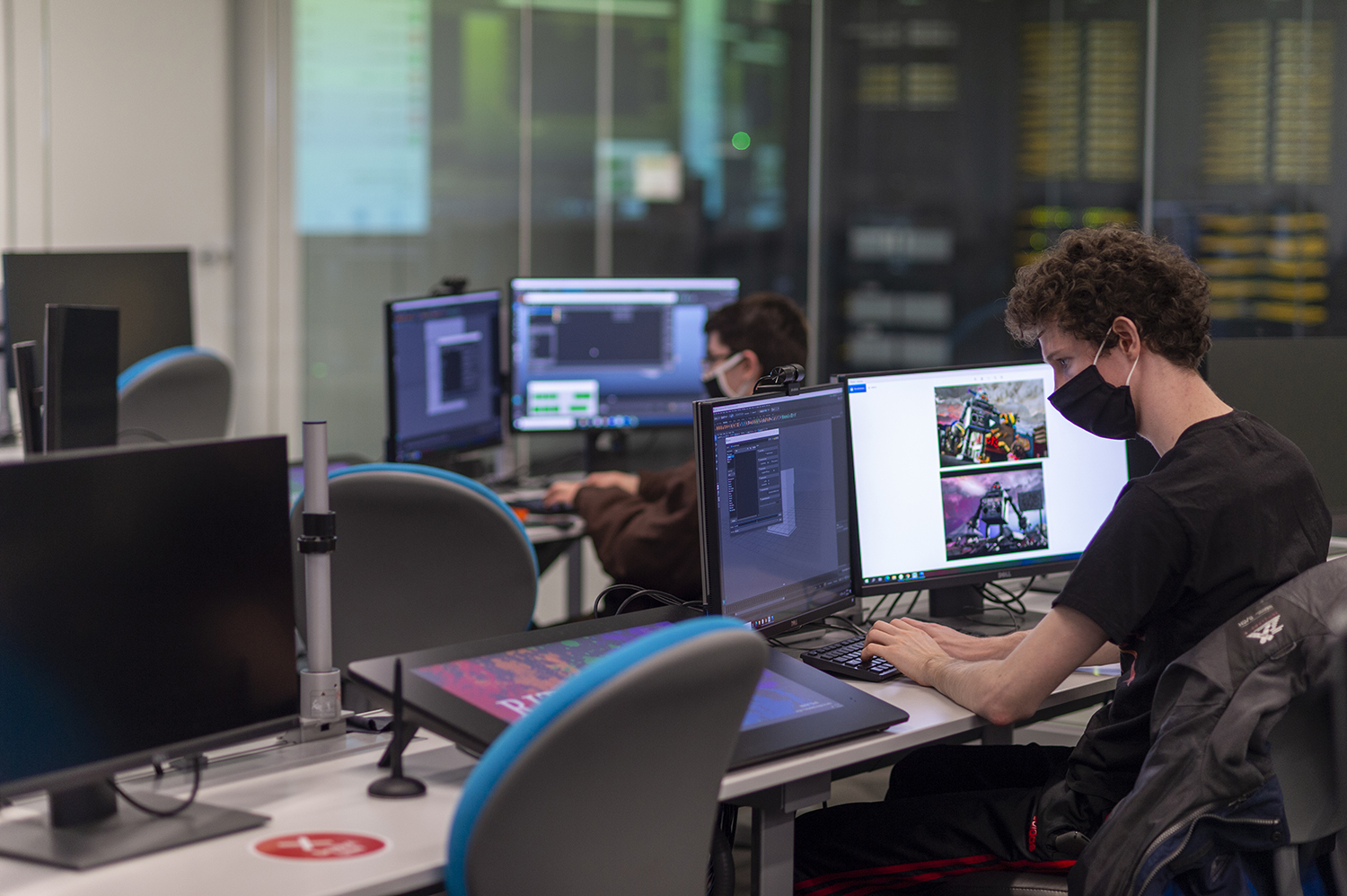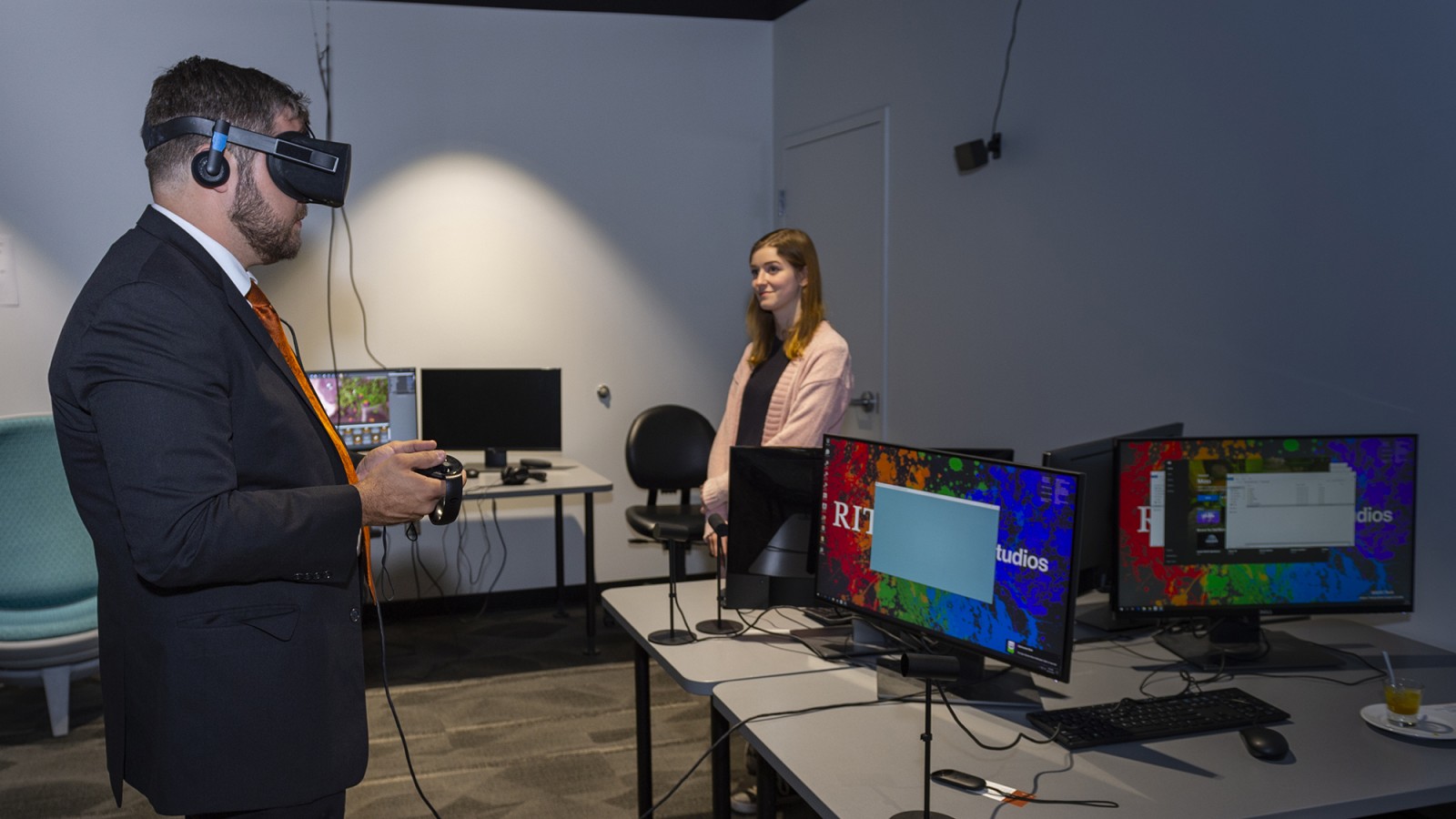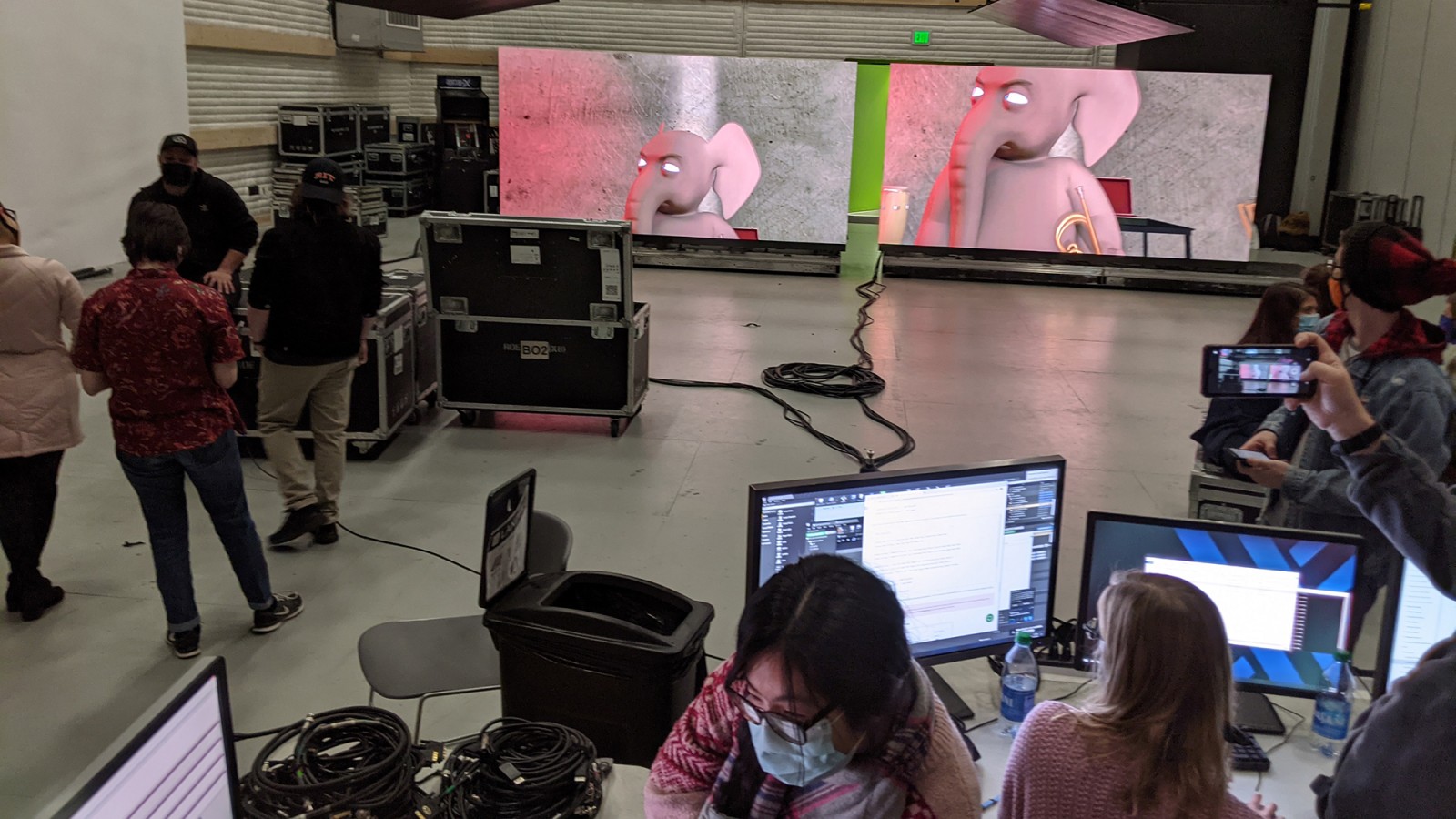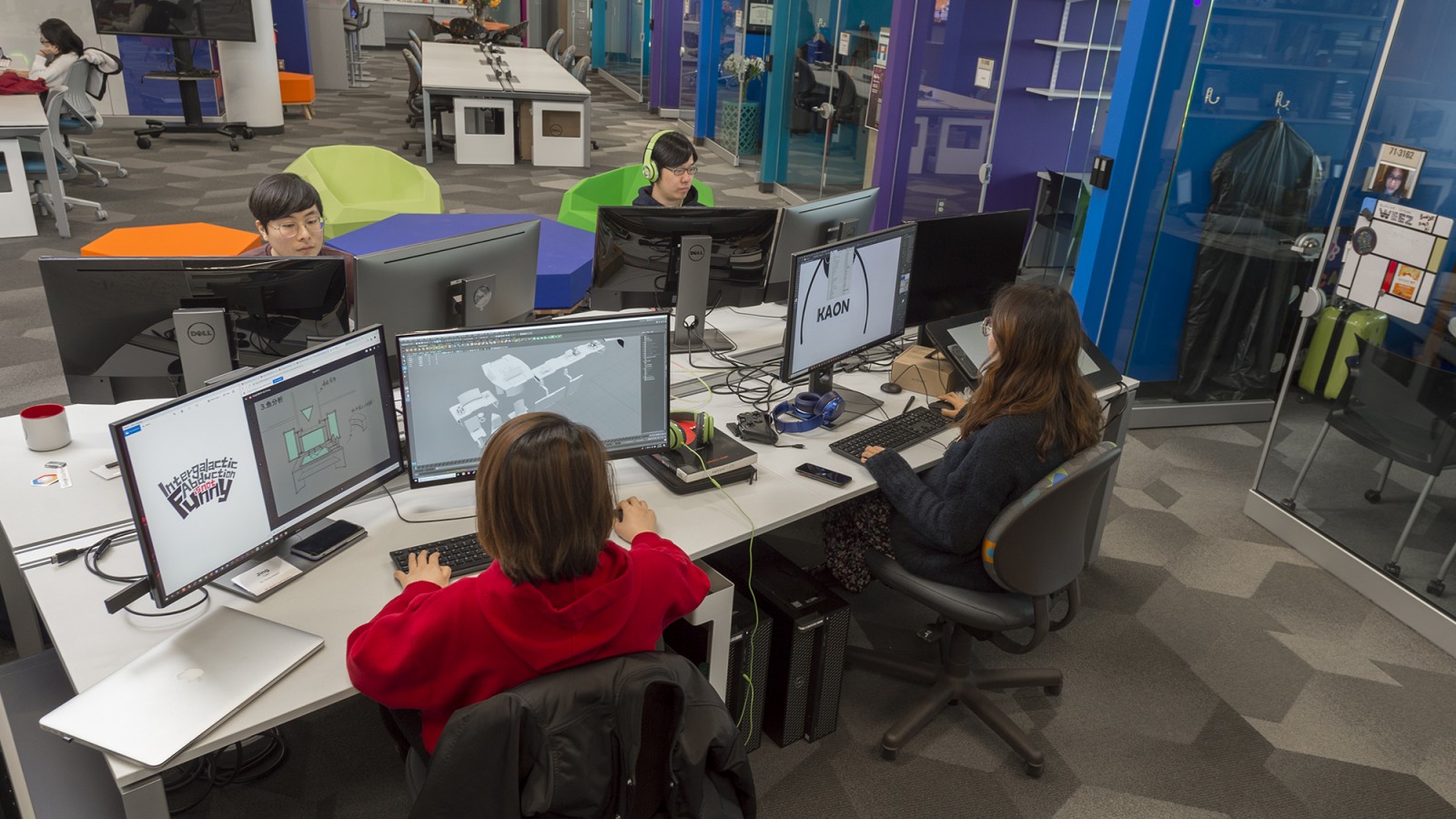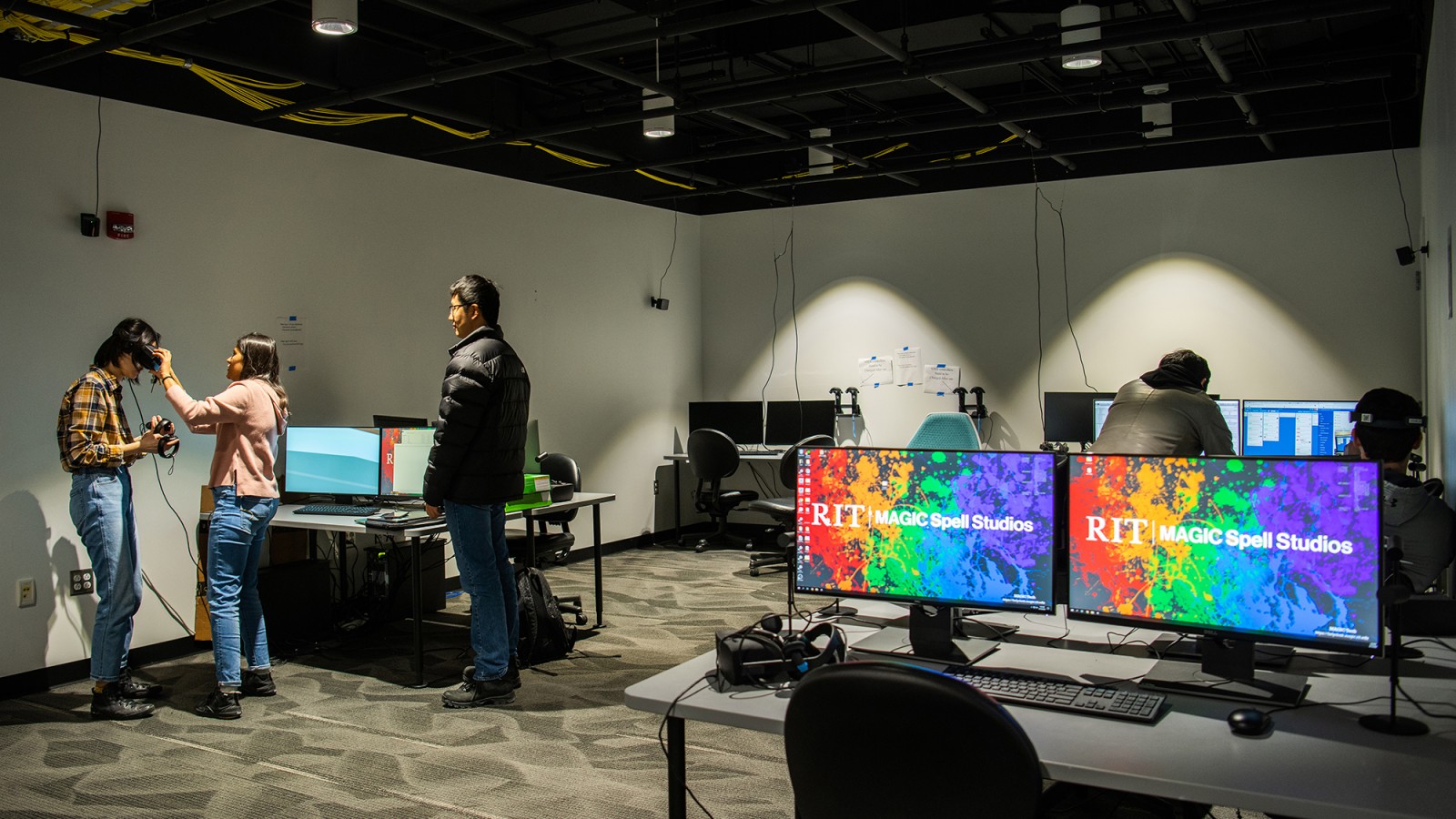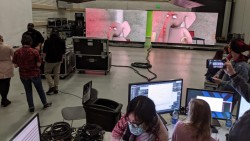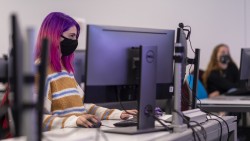Game Arts
Here, we create the visual elements and stories that help drive the assets of video games. Our students, faculty and alumni are behind the creation of the environments, characters and objects in the games you know and love.
RIT's College of Art and Design offers academic programs that allow students to explore creative interests in the game arts field, from designing virtual elements and lighting to animated characters and backgrounds. In addition to a game arts option in the 3D digital design program, our offerings also include animation and illustration.
It's an inspiring blend of technology, the arts and design to make vibrant entertainment or serious games. Those programs take their lead from nationally recognized BS and MS programs in game design and development offered through the Golisano College of Computing and Information Sciences as well as the humanities, computing, and design BS program in the College of Liberal Arts.
Industry Grade
RIT’s relationships with industry facilitate unique explorations for students. In fact, the RIT MAGIC Center and well-known game studio Vicarious Visions (Crash Bandicoot, Tony Hawk) have a partnership agreement that provides students with scholarship and collaborative opportunities. Professionals with experience in game arts, like Danny Williams (above), are also invited to RIT to lead lectures, discussions and demos that give students added perspective of the industry. Photo by Jesse Wolfe.
Collaborative Environment
With RIT being home to an imaginative community of artists, designers, developers, scientists, engineers and more, collaboration is always right around the corner. Those interested in game arts have endless opportunities to team up with students from the Game Design and Development and New Media Interactive Development majors on digital media projects. Photo by Gabrielle Plucknette-DeVito.
Invaluable Resources
Whether it's in the state-of-the-art MAGIC Spell Studios or one of the many computer labs in the College of Art and Design, students have access to professional-level 3D and animation software to build skills and execute projects. Photo by Chase Gunner.
High-impact Careers
Students graduate well-positioned to pursue careers in the game arts industry. Alumni have been hired by leading studios to work on games for all platforms. Hiring partners include: Bethesda, Insomniac Games, Sony Interactive Entertainment and Workinman Interactive. Photo by Elizabeth Lamark.
Facilities
The array of programs and opportunities at RIT aligns with the game industry’s convergence of many different fields. Programs at the university are adaptive, and prepare students for lifelong learning, creativity, critical thinking and skills in future technologies such as VR/AR/XR and virtual production, the revolutionary filmmaking technique combining computer-generated graphics, 3D art, motion capture and real-time rendering via game engines. RIT, with support from an grant from Epic Games, built a virtual production curriculum — driven by the use of large LED walls installed in MAGIC Spell Studios (photo 2).
Project Spotlight

RIT Tiger Courier
A team of RIT students and faculty designed an RIT Tiger courier that could be voted into the wildly popular game Dota 2. With enough votes by anyone with a Steam platform account, the RIT courier will be made available during gameplay.
Working through MAGIC Spell Studios, the team of Maliheh Rahrovan ’19 MFA (film and animation), Sophia Zapata ’20 (new media design) and Jessica Ellison ’22 (film and animation), under the guidance of Assistant Professor Jesse O'Brien, executed the concept art, modeling, sculpting, texturing and animation. Members of RIT’s esports team helped select the winning design, and the result is a fierce hoverboard-riding tiger on a mission to deliver essential equipment to those on the battlefield.

3D Digital Design
This program, with an option in game arts, allows students to explore 3D modeling, sculpting, lighting, materials, effects, real-time game engines (we use Epic Games' Unreal Engine), AR, VR and MR, pre-visualization and virtual production — which blends visual effects, film and game technologies. While technologies keep changing, our program focuses on teaching life-long skills of critical and design thinking, and collaboration.
Faculty Focus

Shaun Foster
Associate Professor, School of Design
Our faculty are committed to sharing cutting-edge innovations with the wider RIT community. Shaun Foster, director of RIT's 3D Digital Design program, completed a $160,000 research project funded by Epic Games, creators of Fortnite and other popular titles. He developed dynamic virtual content, including a series of edX courses, to educate students, faculty and other professionals on the multidisciplinary possibilities of Unreal Engine, an advanced real-time 3D creation tool. Foster explored and elevated the software’s opportunities for collaboration and curriculum improvement.
For the project, Foster had support from faculty and students from various majors: 3D Digital Design, Game Design and Development, Graphic Design, Industrial Design and Medical Illustration.
“It’s a good on-ramp for the multidisciplinary application of the core Unreal Engine software for people who are interested in things like interior design, industrial design and the emerging field of virtual production — which is mixing pre-visualization, filmmaking and visual effects all into one,” Foster said of the edX courses.
Foster also co-wrote a grant with David Long, director of RIT's MAGIC Center, for the development of a Virtual Production Curriculum that was funded by Epic Games for $275,000. Virtual production blends filmmaking, computational photography and real-time game engine rendering to produce in-camera visual effects similar to those seen in groundbreaking work on Disney’s “The Mandalorian.” The grant is bringing those state-of-the-art techniques to RIT.
From RIT to Fallout 4

Madeleine Rabil '13
Environment Artist, Bethesda Game Studios
Rabil is responsible for building out environments for games developed by Bethesda, the creators behind highly popular role-playing franchises like Fallout, The Elder Scrolls and Starfield. She employs different 3D modeling and texturing packages to create and edit assets before using a game engine to assemble each element into a complete scene. Rabil considers her favorite project to be the work she completed for Fallout 4.
Rabil said she thrives on the highly collaborative creative process at Bethesda, which mirrors her experience at RIT, when she involved herself in many multidisciplinary projects.
“Video game development is such a collaborative process that spans multiple disciplines,” Rabil said. “Learning to be able to communicate effectively with people who think differently, or have different priorities, isn’t something that is easily learned in the classroom. After I graduated, I found that experiences working with students outside my expertise was really the closest thing to my real-world circumstances in the workplace. I think that’s something that RIT in particular is uniquely suited to offer.”
Photo by A. Sue Weisler
Crafting a Collaborative Path

Marty Pietras '17
3D Materials Artist, PlayStation
Pietras textures environments for PlayStation titles, creating 3D materials based on real-life counterparts and then digitally painting them into game scenes. For the action-adventure game “The Last Of Us Part II,” Pietras and his team were tasked with imagining the destruction and decay of man-made materials in a post-apocalyptic world.
As an RIT student, Pietras worked on independent game projects in conjunction with MAGIC Spell Studios and Game Design and Development majors. He also applied his knowledge of current and emerging procedural workflows being used in the game industry to a collaborative project with RIT’s Digital Imaging and Remote Sensing Lab in the College of Science. Pietras worked with doctoral students to adapt video game workflows into digital imaging and remote sensing image generation technology used for satellite simulations.
“Each and every one of these extracurricular projects and interactions added to my experience as a 3D artist and as a professional,” Pietras said. “An integral part of the RIT experience was being exposed to these opportunities that would have been hard to find elsewhere. There was so much talent and smart people around me, I just wanted to be part of these cool and interesting things they were doing.”
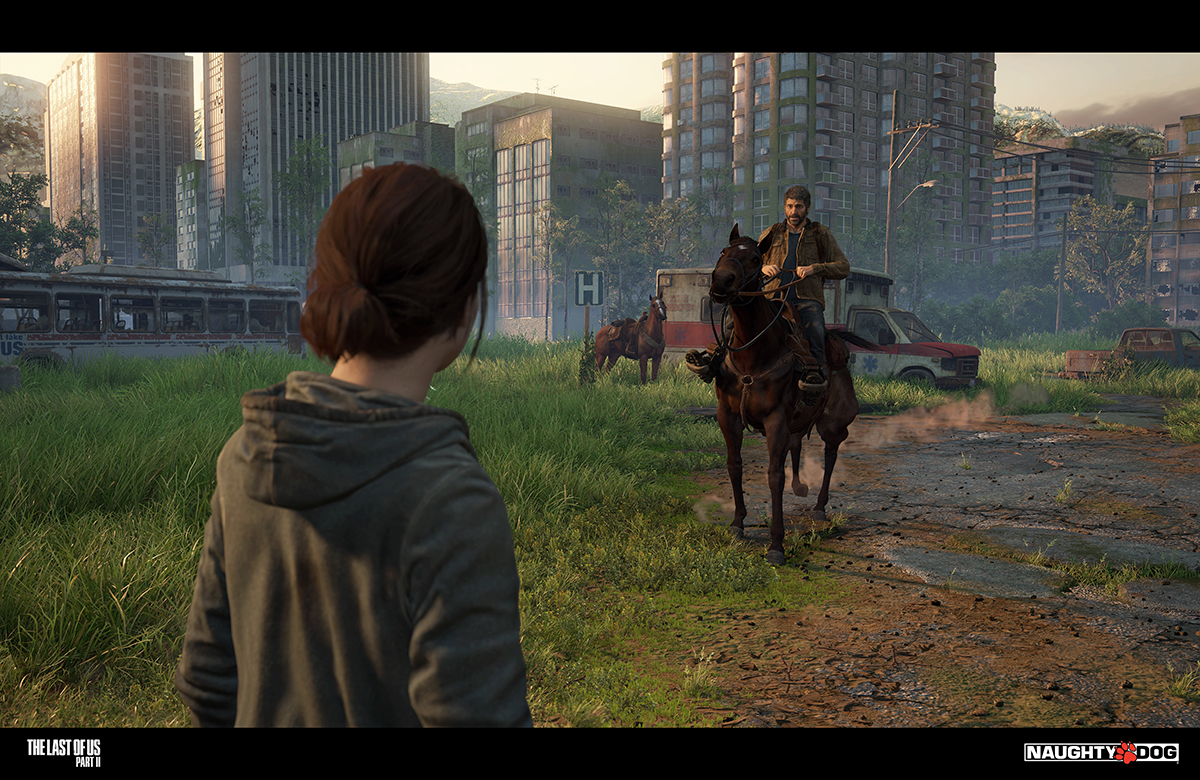
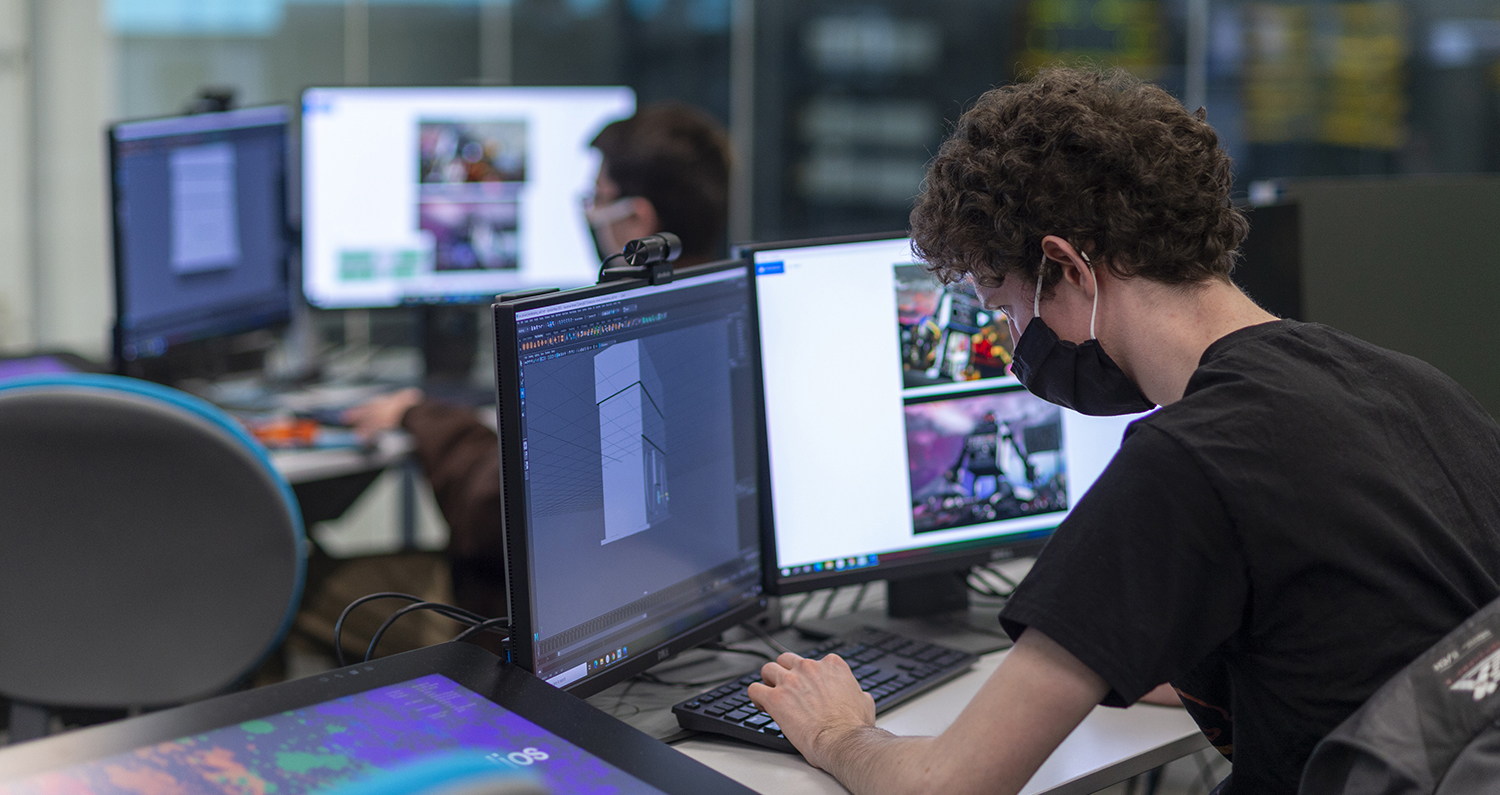
Animation
Whether its 3D or 2D, limited, 8-bit or high-resolution, animation is the visual connection between the art and the game-play experience. Animators provide the movement, the action and the personality of characters in a game, enabling the player to not only become the character, but to conquer their worlds and to make real connections with the player.
Faculty Focus
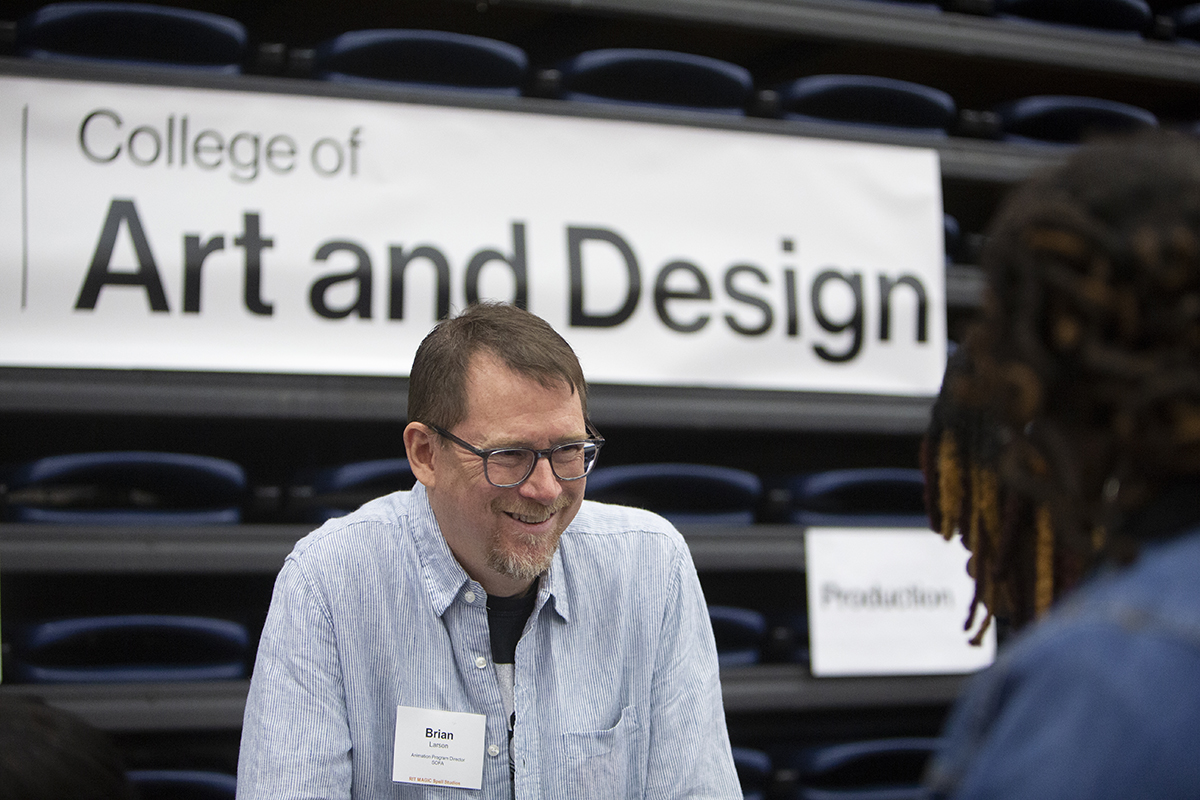
Brian Larson
Associate Professor, School of Film and Animation
Larson is the creative director of “That Damn Goat,” an in-development party game out of RIT’s MAGIC Spell Studios. The project is a collaboration between faculty and students from RIT’s College of Art and Design and Golisano College of Computing and Information Sciences. The development philosophy is faculty-led and student-developed, aiming to mimic standard industry production practices and methodologies to provide a best-in-class student experience.
In 2016, RIT became the first university to fund, develop and launch a game on Xbox One with “Hack, Slash & Backstab” and did so again in 2018 with “Fragile Equilibrium.” RIT is setting its sights on another full game launch with “That Damn Goat.”
Photo by Jesse Wolfe

Shaping the Future

Justine Raymond '12
Senior UI Artist, Proletariat, Inc.
Raymond entered the game industry right out of RIT and has since created art for a variety of console, PC and mobile games. From art direction to 2D generalist game art and beyond, Raymond’s creative touch can be seen in many titles. Raymond’s career includes stints as user interface (UI) artist for Innersloth on Among Us and Young Horses on Bugsnax, as well as lead game artist for Digital Continue, where she successfully shipped titles such as Drawn to Life: Two Realms and Next Up Hero.
Today, Raymond is a UI art lead for Proletariat, Inc. She creates UI assets, shop graphics and motion mockups for in-game user interfaces for the fantasy action game Spellbreak.
"Working as an artist in games means I can help shape the future of inspiring new experiences, and tell stories I love to tell," Raymond said. "It's the perfect intersection of creativity and technology. It allows me to provide players a chance to engage with stunning visuals, to explore new worlds and to experience the magic of new stories. Every day I help people have fun and feel inspired."
Raymond also influences the field beyond her art. She is involved in diversity initiatives within the industry, participates in panels at game conferences and has worked with Google Play on a project spotlighting women in games.
"It's important to use the game industry as a platform for representation," she said. "Working as a woman in games allows me to elevate and empower others to challenge the narrative that this space is not meant for them. Now more than ever, we need diverse voices in games."

Raymond's UI work for Bugsnax, an adventure game for PlayStation and PC.
Blurring the Line Between Film and Games

While she views herself as more video game artist than filmmaker, Amanda Dellostritto ’21 still found RIT’s School of Film and Animation as the right place to execute her ideas. With a deep interest in environment art, Dellostritto spent her time at RIT blurring the line between film and games. Dellostritto took an unconventional path for her senior capstone project, leading a collaboration with School of Interactive Games and Media students on the development of a video game (“You Deserve to Take up Space”) and companion experimental film (“Lucid”). Similarly, Dellostritto produced a game, "Return to Otter Space," with a pair of in-game cinematics her junior year.
“I know like the industry is rapidly changing, and with VR and game engines now becoming more viable for films and cinematics, I think the School of Film and Animation is in a good position to experiment with that and produce more non-traditional films,” said Dellostritto, who was hired as an associate environment artist at Rockstar Games after graduating.
Dellostritto has worked on multiple mobile games, including Table Trenches for game studio DB Creations, through MAGIC Spell Studios. Approached about the project by Jesse O’Brien, senior lecturer in the School of Interactive Games and Media and MAGIC resident faculty member, she was hired as the 3D modeler for the AR battle game.
“MAGIC has opened many doors for me,” Dellostritto said. “The connections I’ve made and the access to facilities and professionals working in the field have been super important. And there is a real sense of community.”
Dellosritto also had the chance to learn, firsthand, about the video game industry outside the U.S. She was part of a study abroad trip to Germany, where seven RIT students participated in a game jam with German students and toured three game studios, including Nintendo of Europe. As Dellostritto sets her sights on a career in game arts, her breadth of experiences and relationships with developers have provided a keen understanding of the full game development pipeline.
“Working with School of Interactive Games and Media students has helped me hone my collaboration skills,” she said. “I’ve learned how to communicate with them and understand their ideas and have them understand mine.”


Illustration
Illustrators provide an interpretation or visualization of a story, script, concept or process. Their work is designed for print and digital media, including magazines, books, websites and video games. Often, illustrations are created with physical media — gouache, oils, pencil, pen, charcoals — and then reproduced digitally. In our program, students learn both traditional studio techniques and digital. The dual exploration develops both their technical skills with critical thinking.
Local Studio, Global Impact
Many RIT Illustration alumni have gone on to work as game artists and designers, including at Rochester-based game studio Workinman Interactive. The company — started by Associate Professor Jason Arena, co-program director of New Media Design, and Keith McCullough ’03 (New Media Design) — focuses on the youth market. Workinman has created more than 1,000 games and interactive experiences for high-profile clients such as Disney, Mattel, Nickelodeon, Nintendo and Sesame Street. Much of Workinman’s workforce graduated from RIT, with a host of those employees (past and present) going through the Illustration program.

Bryan Williams '08
Artist/Animator, Workinman Interactive
Williams has spent his career bringing beloved characters from popular children’s TV shows to video games. As an artist/animator for Workinman Interactive, he mainly creates 2D puppet animations of characters. Williams also has done character concepts, user interface work and 3D modeling and animation.
“Matching and adapting to the styles of many different properties and learning to use new software is essential to the work we do,” Williams said.
Williams has made his creative mark on many games over the years, notably on Nickelodeon’s library of online games. His favorite projects include “Teenage Mutant Ninja Turtles vs. Power Rangers,” the “Super Brawl” fighter franchise and the classic SpongeBob Flash games from his early days with the company. Williams also made and animated monsters for the “Power Rangers Samurai” series.
For Williams, having a committed passion to his work, alongside like-minded colleagues, has spurred inspiring ideas at Workinman.
“Co-workers all being mostly of the same generation and having the shared interest of making/playing video games lends itself to a more comfortable atmosphere,” Williams said. “There are times when you can share excitement about the things you’re going to make and have fun bouncing ideas off each other. You have moments that blur the line between work and play.”
Williams said the work he created in RIT’s Illustration program allowed him to capitalize on a hiring opportunity after graduating.
“RIT helped me build an illustration portfolio that caught the attention of my employer,” Williams said. “The skills I learned with Adobe programs are essential to all the work I've done."
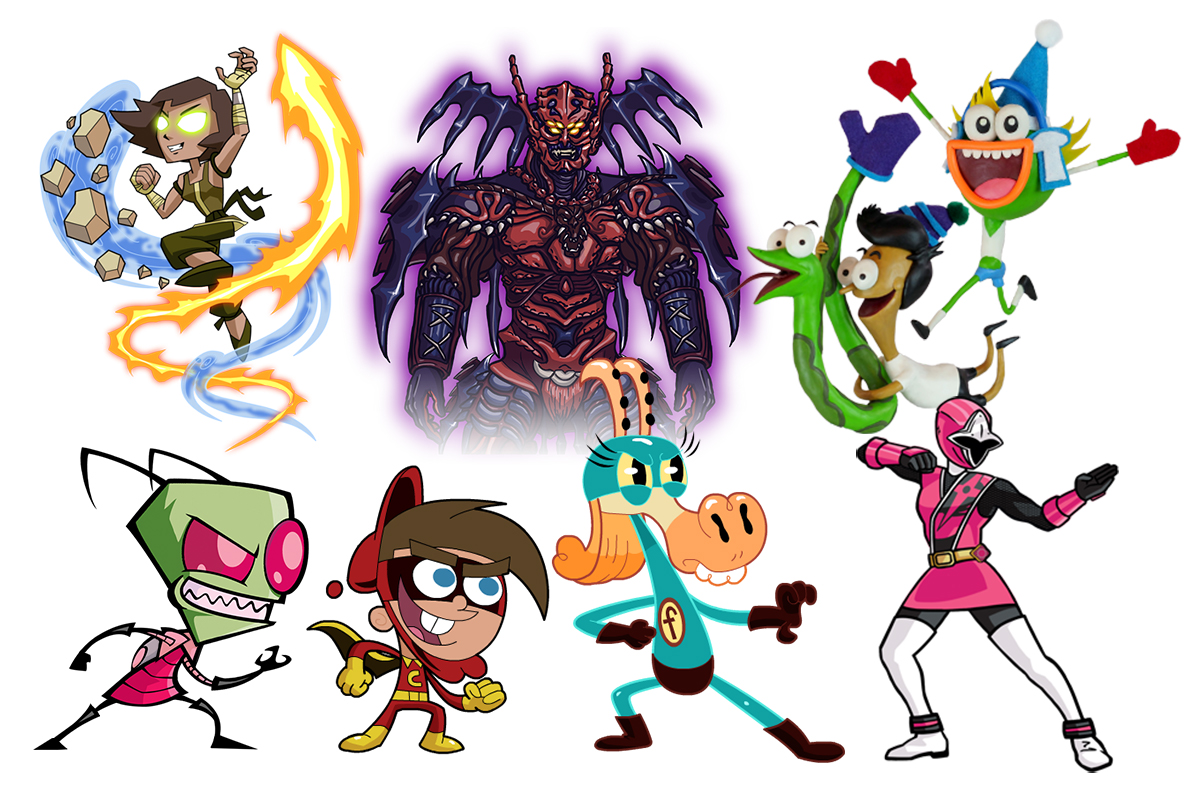
Drawing Out Engaging Game Play
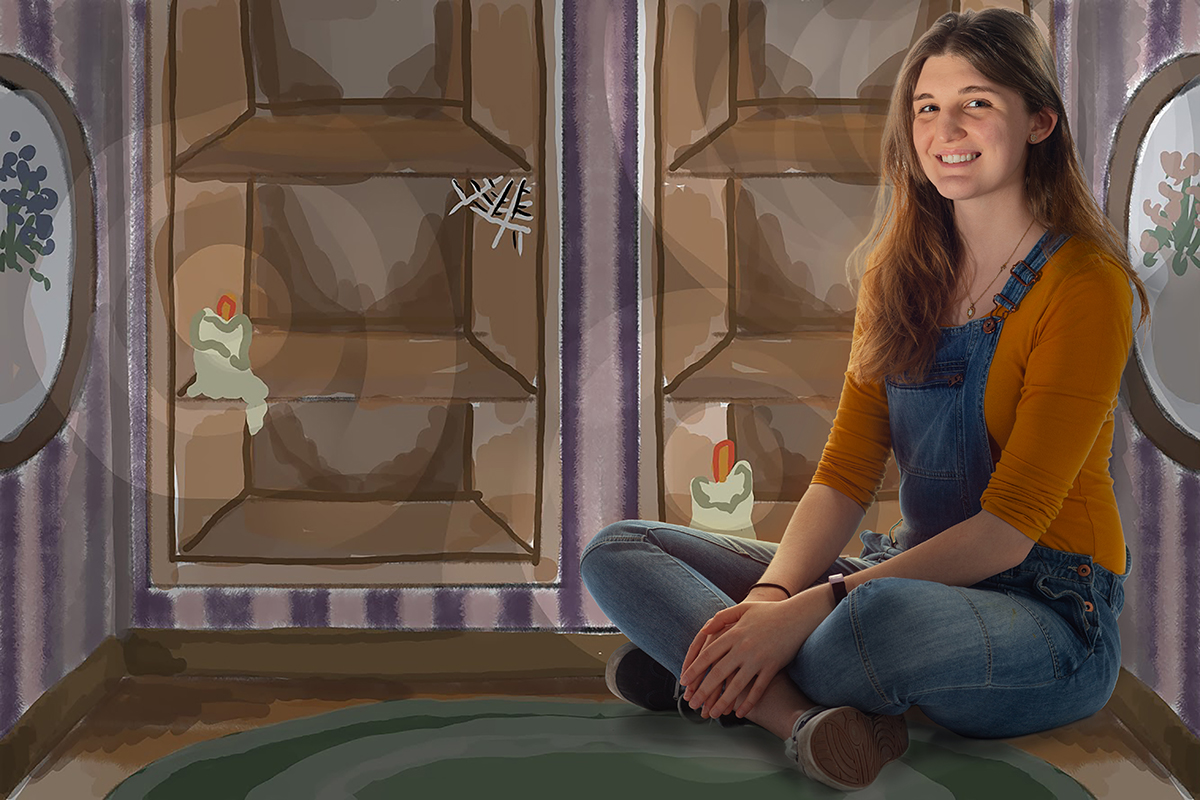
Julie Toich '22
Julie Toich hopes to illustrate for video games or movies once she graduates from RIT. She is getting a jump start while only a junior as she has already created illustrations for two video games — one that is currently available in the Android store called “Riptide.”
“Riptide” was loosely inspired by Chinese mythology. In “Riptide” players are boats sailing on the ocean battling sea monsters. The first boss or enemy encountered is a koi fish who hopes to transform into a dragon but is unsuccessful when it fails to clear a waterfall. As a result, the koi fish unleashes its vengeance. Toich drew and conceptualized all the mobs, including the koi fish, a monkey, a clam, and a pandatee (a panda manatee).
Toich is part of multidisciplinary teams of RIT students collaborating on the development of the games. She is working with students whose majors range from Game Design and Development to Graphic Design to Animation to Ceramics.
In summer of 2020, Toich and the other members of the “Riptide” team landed a spot with the MAGIC Maker program, an entrepreneurial experience which provides students funding and support to create their own digital media for publication and potential investors. Toich worked 40 hours a week, earning a paycheck and co-op credit.
“I was drawing eight hours a day. I had to be creative all the time. I got into a rhythm. It gave me an idea of what it would be like to work in a game studio,” Toich said.
The other game Toich is currently working on is “Necromancer Academy.”
Toich is producing the illustrations and one of her teammates created 3D models for the game in which players can use inanimate objects to create a cat’s anatomy.
“It’s got a cool Tim Burton kind of vibe to it, and it’s a lot of fun to get to play with different aesthetics,” Toich noted.
In addition to honing her technical skills, Toich has learned that communication is just as critical as the creative aspect.
“You have to learn to talk through with people what they want out of the product you are creating," she said. "This is what happens with real-world clients. And sometimes you have clients that don’t necessarily know what they want.”
Composite portrait by Elizabeth Lamark
